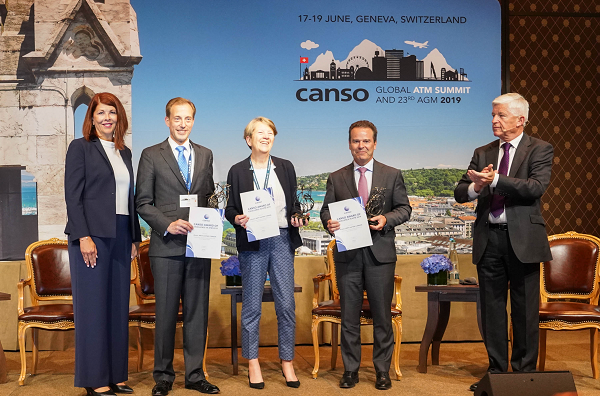Airspace Q3 2019 – True stories

NAV CANADA is leading industry efforts to move away from magnetic north to true north, improving safety and saving millions of dollars annually.
Magnetic variation has always posed a problem for the design and operation of instrument procedures from the enroute through to terminal and approach phases of flight.
Not only that but a working paper presented by Canada at the 13th ICAO Air Navigation Conference noted that “air carriers, air navigation service providers (ANSPs) and avionics original equipment manufacturers (OEMs) spend millions annually managing magnetic variation.”
The problem has continued into the digital age even though aviation doesn’t need the original magnetic reference anymore.
Alaska’s Anchorage International Airport highlights the issue. In 2012, the Federal Aviation Administration (FAA) updated the magnetic variation of the airport. Because aircraft operators couldn’t all follow suit immediately, there was a mismatch between the magnetic variation used in various aircraft systems and the navigation database in the flight management system.
The result was unacceptable lateral guidance when conducting CAT II and CAT III approaches to Anchorage. The incorrect magnetic variation was reissued until the aircraft operators could update their inertial reference system magnetic variation tables.
Indeed, getting airlines to update their systems regularly is known to be a challenge. A Canadian study estimated some were 10-15 years out of date. Already, the National Oceanic and Atmospheric Administration (NOAA) has recommended a mid-cycle update to the World Magnetic Model 2015 as the forecast is deemed no longer valid out to 2020.
As Anthony MacKay, Assistant Vice President, ATS Service Delivery, NAV CANADA, explains, issues with magnetic variation persist largely because “that’s the way we have always done it”.
The background
The use of magnetic north dates back to the earliest days of flight. As soon as aircraft were developed, a heading reference system was required. And the fragile nature of the early aircraft meant that the system needed to be small, lightweight and simple. “Nothing is more simple than a magnetic compass,” says MacKay. “It doesn’t need any power and it always works.”
As navigation systems developed, a heading instrument or directional gyro was used to account for small errors in the magnetic compass caused by dips in the Earth’s magnetic field. Periodically, the pilot would reset the heading instrument to align with the magnetic compass.
In the jet age, the heading instrument was tied to a magnetic sense system eliminating that one step of the pilot reading the magnetic compass and then setting the heading instrument.
“Unless you were flying north or south of 70 degrees latitude, the difference between the moving magnetic poles and the true north and south poles that form the anchors between the latitude and longitude lines around earth were easily handled,” MacKay explains. “Small directional errors in an analogue system were not that critical and the analogue human in the middle could easily adjust and compensate.”
But as aircraft systems became more tightly integrated and digital systems developed, those small errors have become more than a mere distraction, driving a mismatch between the various navigation systems as the Anchorage case illustrates. As MacKay puts it: “If a computer is expecting to see a one and instead it is given a zero, it doesn’t like it very much.”
Today, all modern aircraft with Inertial Reference Systems or Attitude Reference Systems that use cost-effective Inertial technology actually function in true north (TRUE).
“All the systems, all the math under the hood is done in TRUE,” says MacKay. “Then the aircraft systems convert it to magnetic north to show it to the pilot. Today, instrument procedures are built in TRUE and then converted to magnetic prior to publication. Our surveillance systems use latitude and longitude in TRUE and then adjust to magnetic prior to showing the tracks/targets to controllers.”
Advantages
There are many advantages in moving to TRUE, including simplifying technical processes.
Because Magnetic North is always moving, all the procedures and systems built upon magnetic north need to be constantly updated and amended. Switching to TRUE will therefore remove the cost involved for airlines in updating magnetic variation in Inertial Reference Units (usually two or three per aircraft), flight management systems and, if installed, Synthetic Vision Systems.
“Basically, while using magnetic north, every computer system on the aircraft requires updates to maintain the current magnetic value,” he says. “And they all have to match – which sometimes they don’t, depending on the model and the implementation.”
Similarly, for ANSPs, switching to TRUE removes the time devoted to updating IFR approach and enroute procedures with the latest magnetic values. The system would be frozen on TRUE.
Airports, meanwhile, would never need to change runway numbering again. Given the documentation involved in that process, it would be a significant gain. “Essentially, switching to TRUE removes a large and costly time and money burden for all segments of modern aviation,” MacKay insists.
Select the switch
Perhaps the biggest advantage to TRUE is that it can be implemented by simply stopping a process – the conversion to magnetic north. As noted, Inertial Reference Systems on modern aircraft already function in TRUE. Most aircraft have a Mag/True switch that would just need to be selected.
Of course, this solution works for the larger aircraft used in scheduled commercial aviation. General aviation planes that still only have and can only have a magnetic compass or sense system on board would need to either manually do a small plus/minus conversion on what was read off of the magnetic compass prior to setting the directional gyro or use a device that would convert from magnetic to TRUE for them. But these systems for light aircraft are much cheaper than those required to go from TRUE to magnetic on a large aircraft fleet.
Most importantly, however, there needs to be a desire to change. The next step, therefore, is working with ICAO to accept the change and help the industry move towards TRUE. Those meetings have started. There will be objections from small aircraft operators, but NAV CANADA anticipates a lead time to enact the change of 10 or more years.
“It would be more than manageable,” concludes MacKay. “There are millions of dollars lying on the table for the aviation industry to save.”
TRUE in performance-based navigation
Canada’s working paper to ICAO suggests that a true north heading reference in a performance-based navigation (PBN) operation would simplify charting and aircraft operation and reduce costs going forward. In Canada alone, it costs roughly $500,000 per year to manage magnetic variation in various publications. Another $300,000 per year is spent rotating VORs and flight checking modified instrument procedures for magnetic variation changes. Other magnetic variation costs stated by the working paper include:
- Airport signage and runway renumbering
- RADAR alignments
- Aircraft magnetic variation table updates for Inertial Reference Units (IRU) and flight management systems. If an older IRU cannot accept a new magnetic variation table, an IRU upgrade and replacement is necessary
- Industry standards meetings and certification efforts to deal with the current magnetic variation issues affecting the worldwide fleet, including database inconsistencies, loss of CAT II and CAT III certification, RNP issues).



